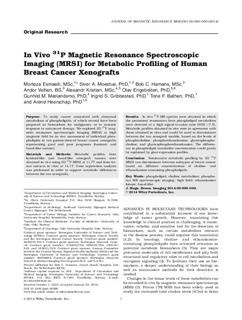| dc.contributor.author | Esmaeili, Morteza | |
| dc.contributor.author | Moestue, Siver Andreas | |
| dc.contributor.author | Hamans, Bob C. | |
| dc.contributor.author | Veltien, Andor | |
| dc.contributor.author | Kristian, Alexandr | |
| dc.contributor.author | Engebråten, Olav | |
| dc.contributor.author | Mælandsmo, Gunhild | |
| dc.contributor.author | Gribbestad, Ingrid S | |
| dc.contributor.author | Bathen, Tone | |
| dc.contributor.author | Heerschap, Arend | |
| dc.date.accessioned | 2017-06-02T11:30:50Z | |
| dc.date.available | 2017-06-02T11:30:50Z | |
| dc.date.created | 2014-01-24T09:10:28Z | |
| dc.date.issued | 2015 | |
| dc.identifier.citation | Journal of Magnetic Resonance Imaging. 2015, 41 (3), 601-609. | nb_NO |
| dc.identifier.issn | 1053-1807 | |
| dc.identifier.uri | http://hdl.handle.net/11250/2444248 | |
| dc.description.abstract | Purpose
To study cancer associated with abnormal metabolism of phospholipids, of which several have been proposed as biomarkers for malignancy or to monitor response to anticancer therapy. We explored 3D 31P magnetic resonance spectroscopic imaging (MRSI) at high magnetic field for in vivo assessment of individual phospholipids in two patient-derived breast cancer xenografts representing good and poor prognosis (luminal- and basal-like tumors).
Materials and Methods
Metabolic profiles from luminal-like and basal-like xenograft tumors were obtained in vivo using 3D 31P MRSI at 11.7T and from tissue extracts in vitro at 14.1T. Gene expression analysis was performed in order to support metabolic differences between the two xenografts.
Results
In vivo 31P MR spectra were obtained in which the prominent resonances from phospholipid metabolites were detected at a high signal-to-noise ratio (SNR >7.5). Metabolic profiles obtained in vivo were in agreement with those obtained in vitro and could be used to discriminate between the two xenograft models, based on the levels of phosphocholine, phosphoethanolamine, glycerophosphocholine, and glycerophosphoethanolamine. The differences in phospholipid metabolite concentration could partly be explained by gene expression profiles.
Conclusion
Noninvasive metabolic profiling by 3D 31P MRSI can discriminate between subtypes of breast cancer based on different concentrations of choline- and ethanolamine-containing phospholipids. | nb_NO |
| dc.language.iso | eng | nb_NO |
| dc.publisher | Wiley | nb_NO |
| dc.title | In vivo 31P MRSI for metabolic profiling of human breast cancer xenografts | nb_NO |
| dc.type | Journal article | nb_NO |
| dc.type | Peer reviewed | nb_NO |
| dc.source.pagenumber | 601-609 | nb_NO |
| dc.source.volume | 41 | nb_NO |
| dc.source.journal | Journal of Magnetic Resonance Imaging | nb_NO |
| dc.source.issue | 3 | nb_NO |
| dc.identifier.doi | 10.1002/jmri.24588 | |
| dc.identifier.cristin | 1098630 | |
| dc.relation.project | Norges forskningsråd: 221879 | nb_NO |
| dc.description.localcode | © 2014 Wiley Periodicals, Inc. This is the authors' manuscript to the article. | nb_NO |
| cristin.unitcode | 194,65,25,0 | |
| cristin.unitname | Institutt for sirkulasjon og bildediagnostikk | |
| cristin.ispublished | true | |
| cristin.fulltext | preprint | |
| cristin.qualitycode | 2 | |
